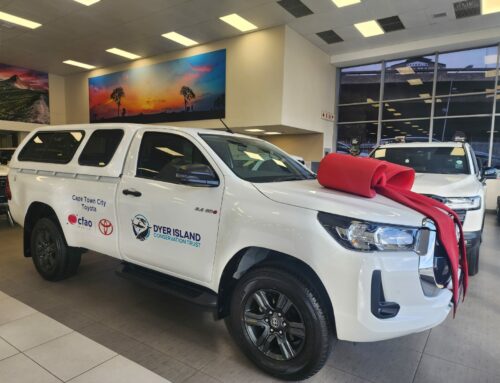SOUTHERNMOST RECORD OF A SICKLEFIN DEVIL RAY
January 29, 2016 by Alison Towner, DICT biologist
On Thursday the 21st January a dead stingray at the Blousloep in Franskraal was reported to the Dyer Island Conservation Trust. It had washed up the day before and a photograph was shown to Marine Dynamics manager Hennie Otto who immediately arranged a team to collect the 220kg specimen from the municipal landfill where it had been discarded. After consulting with expert Dr. Andrea Marshall who identified it from photographs as a male Sickle Fin devil ray Mobulid tarpanaca, DICT biologists began dissecting the devil ray the next morning.
The ray initially washed up with two large remora fish attached. Remarkably they were still alive after having been buried and were released back into the ocean by the DICT. The dissection took three hours and involved detailed measurements and sample collections of the skin, muscle tissue, stomach, gill arches and tooth band areas. Devil rays (mobulids) are closely related to the manta rays. This spectacular specimen was the furthest south ever recorded in Africa for its species!
It was a sexually mature male with an impressive wingspan of almost 3m – they can reach up to 3.7m! Sicklefins are one type of devil ray that can feed on tiny fish as well as plankton, and therefore have enlarged brachial gill arches. According to the new guide on Western Indian Ocean rays the Sicklefins conservation status is data deficient, but with a vulnerable listing warranted in Southeast Asia, largely because of fishing gear mortalities. It is prevalent globally (but scattered) in tropical to warm-temperate seas. It has been reported infrequently in South Africa (Eastern Cape) the Red Sea (Egypt and Saudi Arabia) and Maldives. Dr Marshall’s PhD students will analyse the samples collected for their research.
No obvious cause of death was apparent, however the DICT team concluded that the animal was in poor health as its stomach was empty and its liver was off-colour with a large bile patch apparent.
Ocean conditions such as temperature and currents are under the influence of El Nino at present, a climatic phase which occurs every 4-7 years. The effects of El Nino are felt worldwide, as much on land as in the sea (extensive droughts in SA for example). The devil ray was far out of its normal distribution range, which could be a broader ecological impact associated with the El Nino.
Dr.Marshall: “I was certainly surprised when I was notified of a stranding of this species so far south and I was so pleased that an experienced team was standing by to perform such a comprehensive dissection of the specimen. This years El Nino conditions have resulted in unusual sightings all over southern Africa. More than ever it is important to document how changing environmental conditions are effecting our oceans and I thank DICT for their efforts.”
This was yet another incredible marine research experience for the DICT team to be a part of, their staff and international volunteers thoroughly enjoyed being able to observe the amazing giant and engage with the scientists as the dissection took place. We are incredibly grateful to Mr. Beukes for notifying us of this animal.
If you find any stranded marine species in the Gansbaai area please phone and report to the DICT on 0829075607.





